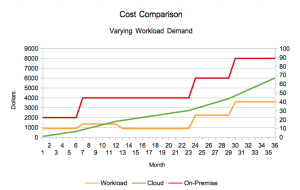The True Value of Cloud is most often expressed in the opportunity to shift CapEx to OpEx. Although this is a massive advantage and very often the number-one reason for companies to embrace Cloud, there is more than meets to eye.
Probably the most obvious unique selling point for the True Value of Cloud is to highlight on the old Capex versus Opex approach. Adopting Cloud and avoiding hardware and software purchases will save money, right? Yes it will! But there is more to look at. Real good things are not always obvious.
To determine true business value of Cloud there are no strict rules or solid models that apply everywhere and every time. As always, it’s a matter of understanding your business and the impact that any new technology can and will have on your business.
Cloud computing is no different. The traditional Capex – Opex balance is losing importance a bit. A Pure financial approach to Cloud is never a good one and is most of the time a too black and white reasoning.
Updated best practices for finding cloud value
For sure, the Capex – Opex balance still resides on the northern part of your list but when you start to determine how much value you gain from the increased agility and time-to-market, which are core benefits of cloud-based platforms, things really fall into place.
Financial agility is achieved through the as-a-Service model where you only pay for the infrastructure you use. In the traditional model, you buy a server with more capacity than you need. You used that server until you are about to outgrow it. then you add a 2nd server. If you demand drops for a few months you have a lot of excess capacity that you must maintain. In a cyclical business, this can be very costly. But suppose the downturn was temporary, as you begin to grow again you will be confronted with the need to by more servers over time, this can also be very costly.
This gra ph demonstrates just such a case. While your specifics will be different, in this scenario the overall equipment cost for the traditional model will be about 33% higher over 3 years. That gap gets even bigger if you account for power consumption.
ph demonstrates just such a case. While your specifics will be different, in this scenario the overall equipment cost for the traditional model will be about 33% higher over 3 years. That gap gets even bigger if you account for power consumption.
Companies too often look at Cloud as a pure financial or pure technical project. When you consider the value of agility and time-to-market as a value attribute to your business, this is when the picture starts to be more complete. Surely, the value of agility and compressing time-to-market is dependent upon the type of organization you are and the weight your organization puts on it. But when you start to factor in the advantages of easy and flexible IT resource deployment the value of Cloud becomes different, even better than you ever imagined. Where traditional IT always was a burden and its inflexibility often delayed or even made projects impossible, Cloud lets you deploy IT resources when and where you need them without any limitation. Think about seasonal industries that are confronted with huge swings in activities and IT needs throughout the year. Or simply, companies that have to answer to market demands when the demand is there, not when their IT allows them to act. For these companies, Cloud is a true blessing and definitely brings a lot of value to the stand.
Finally, think about the additional security and comfort Cloud brings to your business. With Cloud solutions security is part of the package and present all the time. A solid Cloud platform will offer you a complimentaryDisaster Recovery (DR) process that basically brings the same value as having a secondary office with a secondary IT platform with a secondary IT staff. With that difference, you do not have to pay or manage all these secondary resources. With Cloud solutions, DR is just part of the game.
So do not get tempted to look at a Cloud migration from a pure financial or technical issue. If you take a step back and look at the total picture of Cloud solutions, you will find out that ease-of-use, flexibility and security are the real USPs of Cloud. USPs, that are key to any type of business. Also to yours!
